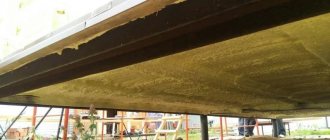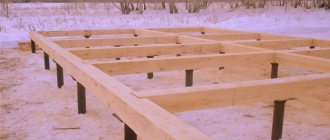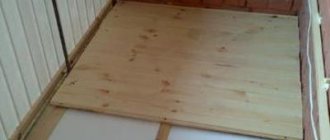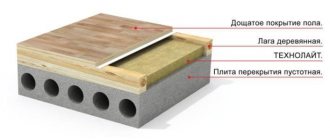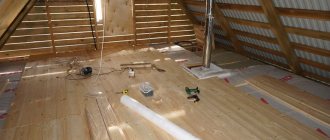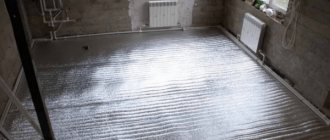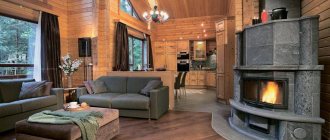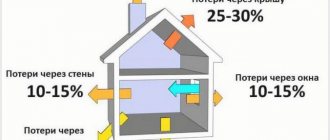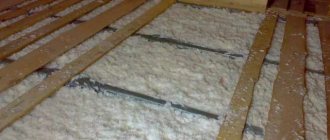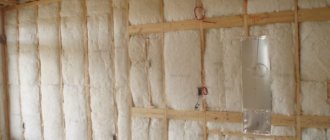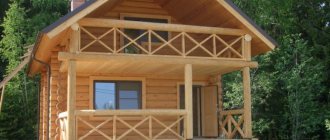- Floor insulation: which one is better to choose for a wooden house
- Choosing material for floor insulation
- How to properly insulate the floor in a wooden house with sawdust
- Subtleties of using mineral wool
- Features of using penofol
- Floor insulation with foam plastic
- Ecowool floor insulation
- Floor insulation with penoplex
- Using the "warm floor" system
- Tips for caring for insulated floors
- Floor insulation: which is the best manufacturer and how much does the material cost?
- Video: floor insulation in a frame house
Floor insulation: which one is better to choose for a wooden house
Floor insulation plays a very important role in the overall insulation of the house. It is best to do this at the construction stage, then for insulation you will not have to dismantle the existing floor covering, and the consumption of time, effort and building materials will be kept to a minimum. If you need to insulate the floor in an already inhabited house, then it will be somewhat more difficult. First you need to decide what will be used as floor insulation , which one is better to choose to create high thermal insulation in a wooden house.
Wooden floors in a private house: options for installation and insulation (read more)
Insulation of a wooden floor with glass wool.
Choosing material for floor insulation
The selection of thermal insulation materials should be treated with maximum responsibility. In many ways, the choice will depend on the financial well-being of the home owner, but you should not save on insulation. Remember that heat loss is the consumption of excess electricity to heat your home, and this means additional financial expenses.
What is the best insulation for floors in a wooden house? You can find out by considering the advantages and disadvantages of each type of thermal insulation material.
Laying sheets of plywood on the joists and filling the voids with stone wool.
The most common materials for floor insulation today are:
- mineral wool;
- ecowool;
- wood sawdust;
- polyurethane foam;
- penofol;
- Styrofoam;
- expanded clay
The insulation is cut according to the size between the joists.
Each of these materials has its own characteristics, as well as installation nuances.
In order to choose the best way to insulate the floor in a wooden house, you should consider the following parameters:
- indoor conditions - average humidity and air temperature, extreme values of these indicators and the frequency of their changes;
- expected thickness of the thermal insulation layer;
- expected loads on the floor and general operating conditions;
- calculated weight of the entire floor structure.
Floor insulation scheme
Insulation of the floor in a wooden house is carried out by creating a double structure, which in the standard version consists of rough flooring, insulation, vapor barrier and finishing flooring. This layered system can withstand significant loads and prevent heat loss.
Double flooring is installed during the renovation of an old house or new construction. This technology is called “insulation of a wooden floor using joists.” It is efficient and easy to implement. Ideal for thermal insulation of floors on the first and basement floors located in close proximity to the ground, as it can significantly reduce heat loss.
Guide to floor insulation
Insulating the floor in a wooden house is a simple process; it can be done with your own hands. The main thing is to take into account such important parameters as the purpose of the room, the average temperature and humidity inside it, the load on the floor, the minimum thickness of the thermal insulation layer, choose a good insulation and follow the technology for its installation.
Stage 1 – laying the subfloor along the joists. This simple and versatile design is most often used in renovations and new construction. Its main advantage is that the insulation is not affected by mechanical loads, so any heat-insulating material can be used.
This floor is made of wooden panels or rough boards measuring approximately 25x150 mm. You can also use boards left over from the foundation formwork for these purposes, provided they are in good condition. In any case, it is recommended to pre-treat the wood with an antiseptic composition.
First, wooden logs are laid, not reaching the walls by about 2-3 cm. They are either installed using the T-shaped cut into the log house, or laid on a foundation, brick pillars or wooden pad at a distance of 0.6-1.0 m from each other . A cranial beam with a cross-section of no more than 50x50 mm is attached to the logs using screws, then shields or rough boards are nailed to it from below, making sure that there are no large gaps left between them.
Stage 2 – laying insulation. Sheet, slab or roll thermal insulation material (foam plastic, glass, eco-, mineral wool, etc.) is placed tightly on a wooden base between the joists, and the remaining gaps are filled with polyurethane foam. Sometimes such insulation is laid under the subfloor.
Sprayed insulation is fixed using special equipment. These materials have good adhesion, follow the contours of the surface and do not form joints.
Stage 3 – laying vapor barrier (waterproofing) material. Waterproofing of the subfloor is mandatory when insulating wet rooms in a wooden house, as well as in the case of using hygroscopic heat insulators. In particular, it is necessary when using fiberglass, ecowool or mineral wool as insulation. At the same time, you can do without it if you use sprayed insulation.
Waterproofing is divided into impregnation, painting and pasting. Pasting materials include polyethylene films, PVC membranes, glassine, roofing felt, isoplast, etc. Film waterproofing materials perfectly protect fiber insulation from condensation and moisture penetration.
Sheets of vapor barrier film are laid over the thermal insulation layer with an overlap of approximately 15 cm, and the edges are folded by approximately 10 cm and attached to the joists. The joints and resulting gaps are glued with metallized tape. Sometimes two layers of moisture-resistant film are laid: a waterproofing layer on the subfloor, a vapor barrier on the insulation.
Stage 4 – laying the finished floor and finishing it. The finished floor is laid on top of the vapor barrier layer at a distance of 3-4 cm from the auxiliary base (subfloor). For its construction, specially treated boards with a width of 9.8-14.5 cm and a thickness of 3.0-4.4 cm are used, which have longitudinal grooves on the bottom side to ensure natural ventilation.
How to properly insulate the floor in a wooden house with sawdust
Using ordinary wood sawdust to insulate a floor is one of the easiest ways to increase the level of thermal insulation.
Sawdust has a number of advantages:
- relatively low cost of the material - sawdust will cost less than mineral wool or expanded clay;
- environmental friendliness - wooden sawdust is absolutely safe for human life and health, does not cause allergies;
- ease of installation - in order to insulate the floor using sawdust, you just need to pour it in an even layer under the floor covering;
- easily poured into hard-to-reach places - sawdust can be used to insulate cracks, gaps and other places where it is impossible to install other types of insulation.
You can also use various building materials that contain sawdust in their composition. This includes sawdust concrete, wood concrete, wood blocks and sawdust pellets. But most often sawdust is used in its pure form.
On a note! When choosing insulation for the floor in a wooden house, you should use sawdust only if you are not afraid of an increased fire hazard. Otherwise, it is better to opt for a less flammable material.
Wooden floor construction with insulation.
How to insulate a floor in an old wooden house
Date: September 15, 2014
Our reader asks:
Hello! We got an old village house. A good-quality wooden frame, quite warm, but cold floor. We often visit it in the off-season and, no matter how hard we fire the stove, you can’t walk on the boards barefoot, your feet get cold. Tell me how I can insulate it, maybe lay something on top? After all, today there are a lot of different insulation materials; the store advised us to use foil Teplon.
Expert answer:
There is no simple answer to your question. Or, rather, there is: most likely, you can only put a traditional rug on the floor of an old village house - and nothing more.
The fact is that in Russian huts (and German houses, by the way, too) they did not not only insulate, but also waterproof the floor, although these technologies have long been known. An unfilled underground space is best combined with stove heating, providing optimal humidity, warmth in winter (the ground does not freeze) and coolness in summer. If your house is really built in accordance with the canons of folk architecture, most likely, under thick floorboards and one or two powerful joists there is open ground, probably well-trodden clay. Yes, you yourself mention something similar. Therefore, even if your hut is built in a dry place, moisture penetrates from the “damp ground” into the underground space. It can go outside through holes in the foundation or into the room through holes in the floor, gaps between boards, and even the wood itself.
Neither waterproofing nor floor insulation was done in a traditional wooden house - only ventilation
If this is the case and there is no waterproofing, placing a thin layer of insulation (cork, foamed polyethylene of any brand, insulated linoleum) on the boards that is impenetrable to water vapor will lead to waterlogging of the floor boards and their accelerated destruction. And the low ceiling of the hut will not allow building an additional layer on top with a breathable heat insulator, a ventilated gap and a new flooring.
Our advice: put carpet on the floor, only on a woven, not solid PVC base. The presence of natural fibers in the pile will make it warmer to the touch. Remove the wool rug from the wall and place it on the floor.
If the carpets do not give the desired result, and the desire to increase the comfort in the home is great, you will have to open up the floors.
To effectively insulate the floor in an old wooden house, you will first have to disassemble it
Remove the boards, level the level with sand if necessary, and carefully spread waterproofing on the ground. It is easier, cheaper and more environmentally friendly to use a vapor barrier roofing film, carefully pressing and gluing it to the foundation and the columns on which the logs stand. You can press it with wooden planks, and glue it to uneven concrete or rubble with construction sealant or assembly adhesive. Place a layer of mineral wool, glass wool on the film or sprinkle expanded clay, perlite, agloporite, and broken foam glass.
Expanded clay is not the most effective, but inexpensive and almost non-moisture-absorbing insulation.
Thermal insulation based on organic materials (sawdust, fire concrete, ecowool) can be used if you are sure that moisture penetration has been completely eliminated. A layer of insulation of any type - the thicker, but between it and the floor boards it is necessary to leave a gap of at least 4 cm for ventilation.
Don't forget about the ventilation gap
Now you can lay the boards back, at the same time checking their condition and treating the reverse side with a protective agent - they will last longer. And if you really want to create comfort, as in the royal chambers, you can contrive to remove the sleeve from the stove, cover the insulation with windproofing to prevent dust, and, if necessary, blow warm air into the underground space with a fan. But this is a topic for another discussion.
Various options for insulating a wooden floor on the ground. Details depend on the features of the existing structure, but in all cases waterproofing is required
And, in fact, it’s not appropriate to walk on the floor in a hut barefoot, but in homemade felt boots 
Subtleties of using mineral wool
If the question arises about what is the best insulation for the floor in a wooden house, then mineral wool is one of the most popular options today. Firstly, mineral wool represents the optimal combination in terms of price and quality. Secondly, it has a lot of advantages:
- low level of thermal conductivity, due to which heat loss in the house during the cold period is minimized;
- high water repellency, that is, mineral wool does not allow moisture to pass through, so this type of insulation can be installed in houses with high humidity;
- non-flammability of the material, which greatly reduces the risk of fire in a wooden house;
Laying a thermal insulation layer.
- durability - insulating floors in a wooden house from below using mineral wool guarantees you a long service life of the insulation, much longer than sawdust or other similar materials;
- environmental safety – mineral wool is absolutely safe for human health and does not cause allergies;
- high level of resistance to rotting - this type of insulation withstands the effects of aggressive chemical environments, tolerates temperature changes and other adverse effects;
A combination of penofol and mineral wool for better thermal insulation.
- affordable price - mineral wool is more expensive than sawdust, but cheaper than many other insulation materials;
- high level of sound insulation. By insulating your home with mineral wool, you not only reduce heat loss, but also minimize the noise level entering the house from the street.
A number of disadvantages of the material arise from its advantages. One of the main ones is low vapor permeability, which is why water condensation can accumulate on the insulation. If you plan to insulate the floor using mineral wool, then you should take care of a good vapor barrier.
Thermal insulation of the floor is carried out using mineral wool between the beams.
In addition, mineral wool cakes over time, and thermal insulation is reduced. Therefore, when insulating a wooden floor from below in a private house using mineral wool, several overlapping layers should be installed.
Mineral wool is installed without gaps, and a vapor barrier layer is laid on top of the insulation layer, with the seams being taped. This will protect the insulation itself from moisture condensation on it from warm air from the house.
Correct installation of penofol under wooden logs.
Features of using penofol
Penofol has been used for floor insulation relatively recently, and is not yet very popular. It is a roll of material that consists of several layers: insulation and reflective aluminum foil.
When insulating the floor with penofol in a wooden house, you get the following advantages:
- Simplicity and ease of installation - penofol can be installed even without special skills in the field of construction.
- High resistance to mechanical loads - the material can withstand high pressure, shock and much more.
- The high density of the material allows it to be installed in a not too thick layer.
- When insulating the floor with penofol, you do not have to additionally install a vapor barrier, since condensation does not concentrate on this insulation.
Options for installing floors in a frame house.
On a note! When buying penofol for floor insulation in your home, do not be alarmed by its relatively high price: the excellent performance characteristics of the material more than compensate for it.
How to properly insulate floors in a wooden house using penofol? To do this you need to do the following:
- First, the waterproofing layer is installed. This could be a special film or just an additional layer of penofol.
- Then the insulation itself is laid, all seams and joints are filled with polyurethane foam.
- Wooden logs are mounted on top of the foam foam layer. The distance between them should be at least 50 cm.
- Penofol is again laid between the lags, and all seams and cracks are filled with polyurethane foam.
- Wooden boards or chipboard sheets are laid on top.
Penofol has vapor barrier properties, which simplifies the work on floor insulation.
Floor insulation with foam plastic
Polystyrene foam is another type of insulation, which in popularity is almost on the same level as mineral wool. It differs favorably from the latter in that it does not absorb moisture, does not cake and, accordingly, does not lose its thermal insulation properties over time.
Insulation with foil: use of foil penofol (read more)
In addition, when insulating the floor in a wooden house from below using polystyrene foam, you get the following advantages:
- The material has a high level of strength and withstands mechanical stress well.
- Low level of thermal conductivity, that is, even a relatively small layer of foam will prevent heat loss in your home.
- Fire resistance.
- Resistance to various types of negative environmental influences. Foam plastic successfully resists aggressive chemical environments and temperature changes.
- Polystyrene foam is not afraid of rodents, so if you need a type of floor insulation in a wooden house against mice, then it will be an excellent option.
- Does not rot or mold.
When replacing the floor, the insulation can be reused if its condition allows this.
Floor insulation in a wooden house
Insulation of the floor in a log house must be carried out, since it is through the lower part that the building loses a large amount of heat. To do this, a subfloor is attached to the joists: it should be located between the beams; slabs and other cheap lumber can be used to make it.
Then a waterproofing layer is laid between the beams, on which the insulation is placed. It is important that the waterproofing is reliable, and that the insulation boards themselves are laid slightly overlapping so that there are no gaps left.
The insulation material is covered with another layer of waterproofing, after which it is covered with finished floor boards. Any external covering can be laid on top - laminate, linoleum, parquet boards, etc. The multi-layer structure of the floor structure will provide both strength and protection from rotting and the harmful effects of moisture.
Ceiling insulation is carried out in a similar way: a waterproofing layer is placed between the ceiling beams, on which mineral wool is laid. This material is breathable and quite effective for insulation.
It is also recommended to insulate the outside of the foundation. For him, this will provide additional protection from freezing in winter, which means he will suffer less from ground movements. Comprehensive insulation work makes it possible to protect the house from the cold from all sides and significantly reduce heat loss.
Yulia Semenenko
Author of publications on 1Drevo.ru with the topics: Windows for the dacha | How to caulk a log house | House with terrace | Foundation for a house | Selection of rounded logs | Log gazebos | Insulation of the terrace | Veranda for children | Rounded timber | Unplaned timber | Calibrated timber | Combined timber | Log house of Russian bath and others.
Collections of publications on topics:
Wooden house inside How to sheathe a house made of timber with insulation Caulking a house Thermal insulation of a house Insulation of a house made of logs Floor insulation Ceiling insulation Log house insulation Wall insulation Penoplex insulation
Was this publication useful to you?
Bookmark it on social networks!
Total score: 4Votes: 4
Beginning of the assembly of the log house - laying and processing of the first crown
Finnish log cutting technology - what are its features and advantages
We recommend! — Encyclopedia Wooden Houses — NEW
You can find out detailed and expanded information on the topic of the article from the book “Wooden Houses,” which reflects all stages of building a house, from laying the foundation to installing the roof. Book price = 77 rubles.
You may also be interested in other BOOKS on building houses from wood with your own hands.
We recommend other posts on this topic:
Insulation for a wooden house - inter-crown and for external walls
Waterproofing a bathroom in a wooden house
How to insulate the facade of a wooden house efficiently and cheaply
What treatment is needed for a log house?
Ends of log logs: features of processing and protection
Do-it-yourself insulation of a log house from the outside
Ecowool floor insulation
When insulating the floor in a private house with your own hands using ecowool, it is worth considering that this will be less effective and will take more time than installing the same insulation using special blowing machines. Nevertheless, it is possible to insulate a floor with ecowool without using specialized equipment. To do this, sheets of material are laid between pre-assembled wooden joists.
The advantages of ecowool are a high level of thermal insulation, impressive durability and resistance to adverse environmental influences. The disadvantage of the material is its high cost and the need to use specialized equipment for high-quality installation. A video of insulating a floor in a wooden house using mineral wool with your own hands greatly simplifies the process, so don’t be lazy to watch it before starting work.
Ecowool is resistant to fire due to non-volatile flame retardants in the composition.
What is the best way to insulate the floor in a wooden house?
Floor insulation in wooden houses is carried out using different materials that have the same characteristics. The simplest and inexpensive insulation materials used are sand or expanded clay, which are poured in a layer on top of the floor roughing, which serves as an auxiliary base.
These materials are sufficiently hygroscopic, they protect the wood from rotting, the appearance of fungus and microorganisms, and also ensure air movement. However, this method of thermal insulation has a significant drawback: bulk non-metallic insulation materials lose their hygroscopicity over time.
Introductory video guide
A country house made of logs or timber is an environmentally friendly home, so the materials for its insulation are also subject to environmentally friendly requirements. This will help preserve the unique natural aura! Previously, sawdust, granulated sawdust insulation, sawdust concrete, wood concrete, and foam plastic were widely used to insulate floors. But today there are more convenient and effective materials on sale that are also environmentally friendly.
Floor insulation with penoplex
If you are insulating a wooden floor at home with penoplex, then the installation scheme is the same as in the case of mineral wool. First, a layer of insulation is laid, then the seams are filled with polyurethane foam. If necessary, penoplex can be laid in several layers.
The advantages of the material are as follows:
- When insulating with penoplex, a vapor barrier is not needed, since condensation does not accumulate on it.
- Penoplex is not afraid of rodents and insects; it does not need to be additionally protected from moisture or mechanical damage.
- The material boasts a solid service life, while its thermal insulation properties do not change over time.
Penoplex is used as a thermal insulation material for floor insulation.
The only significant disadvantage of penoplex is the fairly high price of the material. It costs more than mineral wool or polystyrene foam, but has better performance characteristics.
Materials for floor insulation
The modern market offers a wide range of materials suitable for insulating wooden floors on joists. You can see the properties of the most commonly used insulation materials in the following table.
Table. Popular insulation materials
| Thermal insulation material | Basic properties |
| Sawdust | One of the most budget-friendly, and sometimes completely free, thermal insulation materials. It is characterized by good thermal insulation properties and helps normalize the level of humidity inside the floor structure. The main disadvantage of sawdust is its poor resistance to various types of insects, fungi and other harmful microorganisms. In addition to this, the material supports combustion, which is also a big disadvantage. |
| Mineral wool insulation | Materials based on mineral wool are characterized by high thermal insulation properties and do not support combustion. Along with this, the material does not tolerate contact with moisture well - under the influence of water it swells and loses its original performance characteristics. If mineral wool is used for insulation, waterproofing will need to be installed on both sides of the material. |
| Expanded clay | A relatively inexpensive and easy-to-use material with good thermal insulation characteristics. For insulation, it is recommended to use granules of different sizes - this will make the backfill more dense. |
| Styrofoam | One of the most popular insulation materials. It is sold at a relatively affordable price, provides highly effective insulation, is not afraid of contact with moisture, but supports combustion, releasing substances that are unsafe for human health. In addition, foam plastic attracts rodents, “encounters” with which do not have the best effect on the service life of the material. |
Using the "warm floor" system
If you want to use the most advanced technologies, then the “warm floor” system comes to the rescue. This can be a network of pipelines with hot water, which is installed under a layer of insulation or a flooded floor.
Installation of water heated floors on polystyrene foam mats.
However, a much simpler option to install and operate is electric heated floors. You can purchase such a system at any specialized store and install it without having specialized skills in the field of construction. The price of floor insulation in a wooden house based on such a system will be quite high, but its effectiveness is worth it.
Option No. 3. We insulate the floor of a wooden house standing on a concrete slab
The floor in a wooden house on a solid concrete base can be insulated using two technologies: installation on joists or arrangement of screed. In fact, it is much easier to insulate a concrete slab. Penoplex is laid in a continuous layer on the surface, the cracks are filled with foam. After which you can choose: either lay a metal reinforcing mesh on it and pour a screed, or arrange a flooring made of plywood, OSB or plasterboard and install a laminate on it using floating technology.
Reinforcing mesh for screed on Penoplex
If you want to use installation on joists, then you need to mount a wooden sheathing to the concrete slab. It essentially replaces our load-bearing logs. The step for laying the sheathing guides can vary between 50-70 cm. If you want to cover the floor with thick plywood or OSB, the step is reduced to 30-40 cm.
Option for insulating a wooden floor on concrete
If you are planning to install a heated floor system, then in this case it is worth considering the following scheme.
Concrete screed for heated floors, diagram
Tips for caring for insulated floors
After completing the installation of insulation, you should regularly take measures to care for the floor. This will help extend its service life and maintain high thermal insulation properties.
Attaching water floor pipes to reinforced mesh.
To do this, you need to follow the following recommendations:
- do not walk on the insulated floor in street shoes - small pebbles, dirt and solid particles act on the floor like sandpaper;
- For cleaning, it is best to use a powerful vacuum cleaner; it will effectively remove all dust even in the most difficult to reach places;
- direct sunlight has a bad effect on wooden floors, so it is worth protecting it from their influence;
- where the maximum level of load on the floor is expected, it is better to protect it with mats.
On a note! The biggest enemy of a wooden floor is moisture. Therefore, great attention should be paid to waterproofing. To do this, you can lay a moisture-resistant coating in places where water is expected to be exposed.
Electric heated floor on a wooden surface.
It doesn’t matter whether you use expanded clay, mineral wool, polystyrene or a “warm floor” system to insulate floors in a wooden house, following these recommendations will allow you to significantly extend the life of the insulation and prevent loss of thermal insulation properties.
Floor insulation: which is the best manufacturer and how much does the material cost?
In the modern market of manufacturers of floor insulation materials, there are several popular brands that are most often used for thermal insulation of private houses:
Cable system for heated floors.
- Rockwool is one of the most popular brands, producing basalt insulation for walls, roofs and floors, characterized by high quality, density, and non-flammability. Available in slabs. The price per square meter of insulation can vary from 135 to 200-250 rubles, depending on the brand.
- Euroizol is a mineral wool-based insulation material, non-flammable, with high compressive strength and low water absorption. The price per cubic meter is about 4,000 rubles.
- Linerock is a ventilated non-flammable insulation material, sold in slabs and used for insulating facades and floors. Price - from 140 to 170 rubles per square meter.
- Isover is a glass wool-based insulation material characterized by high tear density, strength and resistance to physical influences. The cost is about 150 rubles per square meter.
Expanded clay is used for insulation and soundproofing of floors.
In addition, brands such as Ecover, Ragos, Techno, Knauf and many others are used for insulation. In order to learn how to insulate the floor in a private house with your own hands using each of them, it is recommended to watch video instructions on the Internet or read advice from experienced builders.
